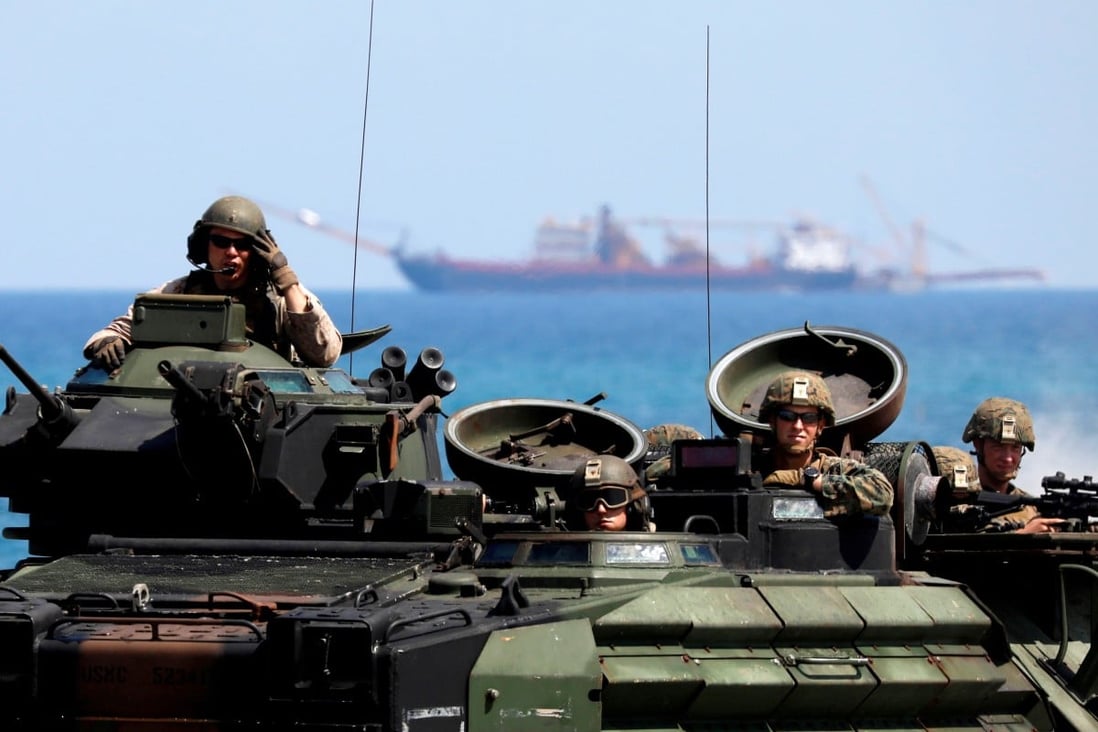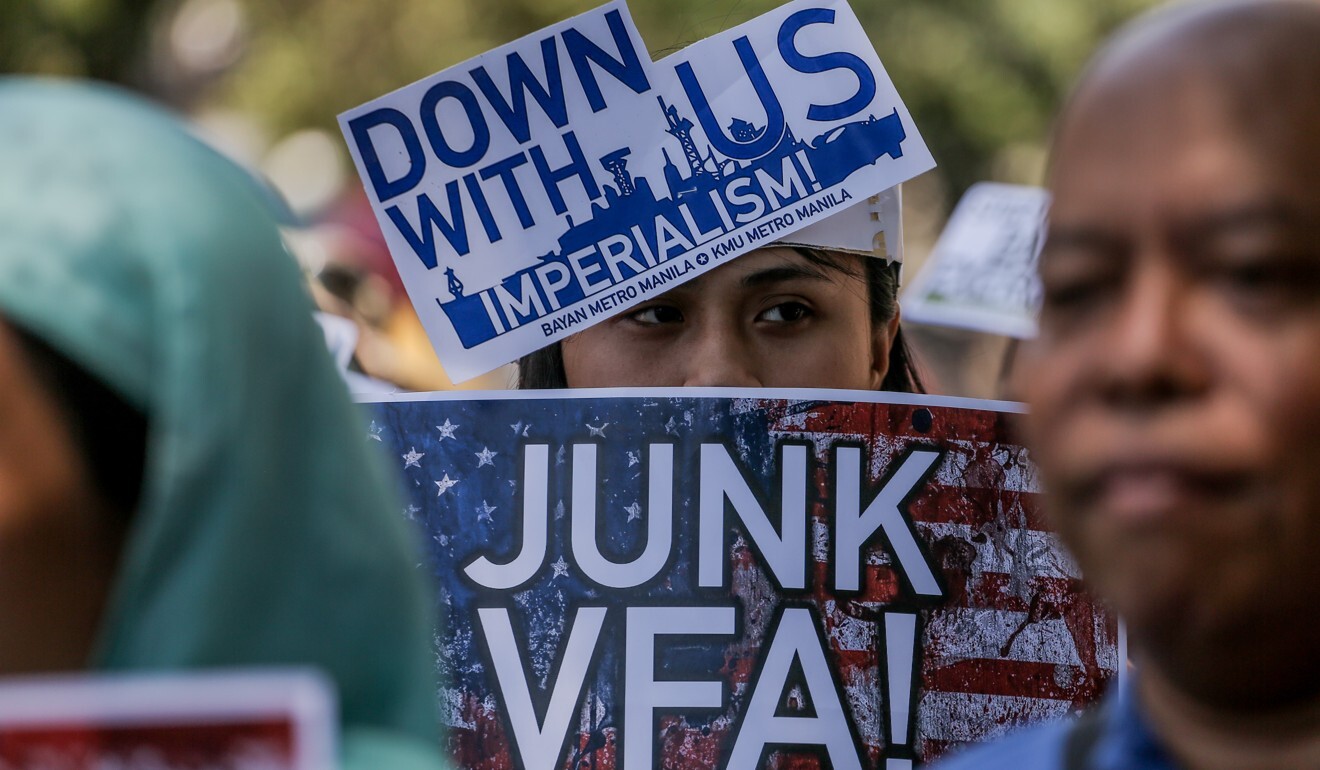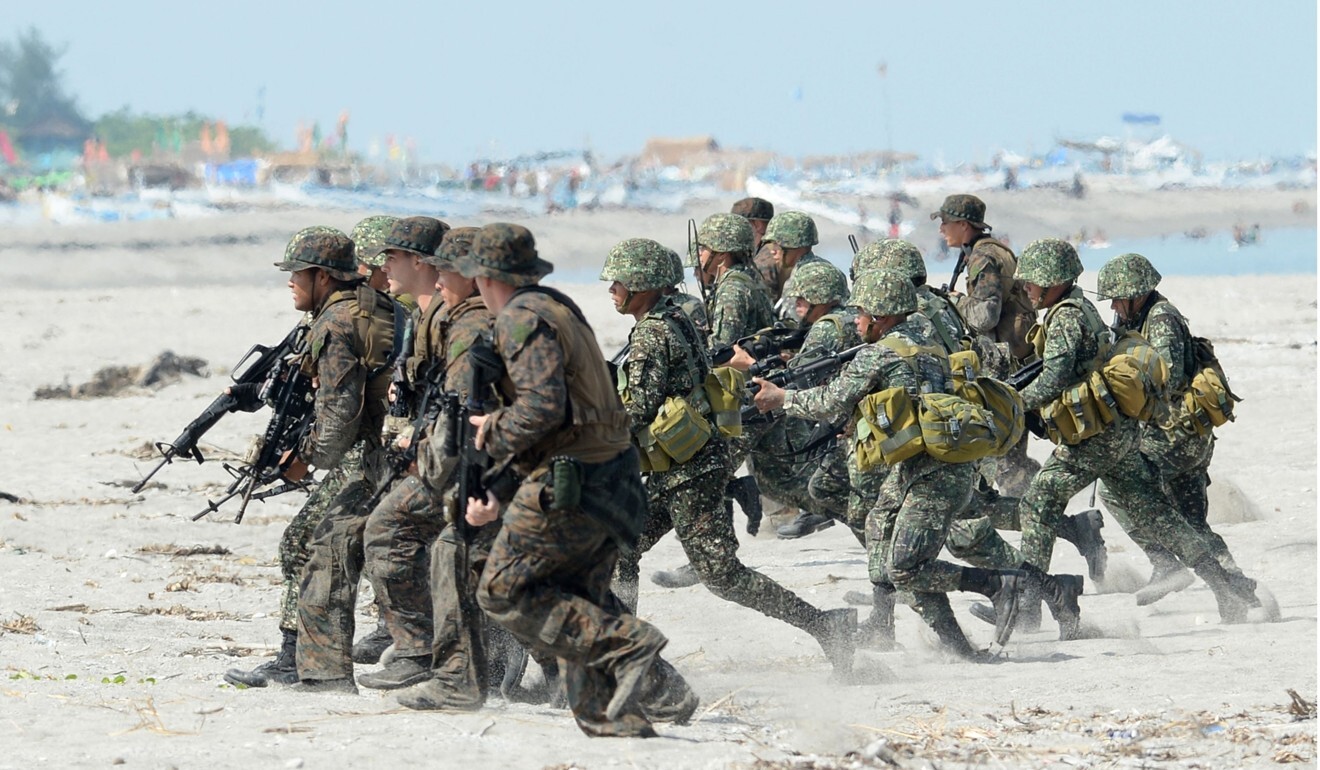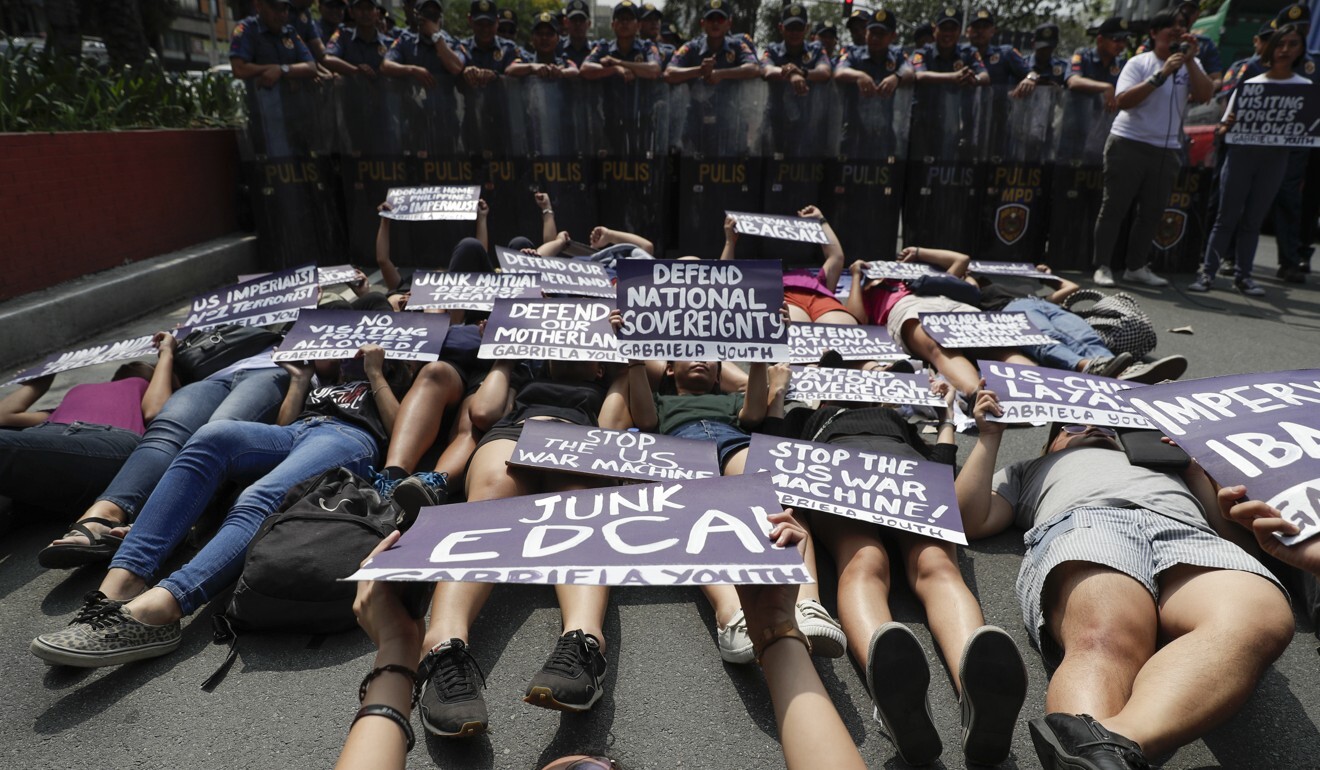Posted to the South China Morning Poste (May 17, 2021): US ready to pull troops from Philippines ‘in months’ if no new VFA: expert (By Raissa Robles)
- Special forces involved in fighting Islamist terrorists in Mindanao could be pulled out by June if no new Visiting Forces Agreement is signed, US forum told
- Warning over pact, in question since Rodrigo Duterte’s former police chief was denied a US visa, comes as alliance in South China Sea is called a ‘paper tiger’

US Marines take part in an amphibious landing exercise during US-Philippines war games. Photo: Reuters
Some 400 American soldiers and defence contractors deployed in the southern Philippines could be pulled out within months if Washington and Manila do not sign a new Visiting Forces Agreement (VFA) by then.
So heard an international conference titled “The Philippines Hedging Between Alliance or Appeasement: Can the Biden Administration Tip the Balance?”
The US was “ready to withdraw” the contingent of soldiers from the Mindanao island group, where they are involved in operations against Islamist extremists and communist rebels, Renato De Castro, an international relations professor at De la Salle University in Manila, told the webinar hosted by the Weatherhead East Asian Institute of Columbia University on Friday.
Asked to elaborate in a one-on-one interview on Sunday, the specialist in Philippines-US security relations said a defence attaché from a Southeast Asian country had told him last week that the Americans would “be withdrawing all troops by June or July if no new agreement comes out”.
Since 2002, in the wake of the World Trade Center suicide bombings the previous year, the
United States has maintained a rotational presence of troops in the Philippines to fight Islamist militants.
Until 2015 the troops had operated under the umbrella of the Joint Special Operations Task Force-Philippines (JSOTF-P), consisting of Navy SEALs and special operators drawn from the US marines and army. At one point there were as many as 600 military personnel involved in the task force, but it was disbanded in 2015 and since then the US presence has fallen to around 400 troops who are referred to as military advisers, according to the US Naval Institute.
De Castro said he understood the advisers would not remain under the present scenario in which the VFA needed to be renewed every six months. “It’s creating uncertainty. So they might as well pack their bags and leave,” he said.
De Castro said that if this happened it would compromise government counterterrorism operations against Islamic State-linked groups and communist rebels.
De Castro, a former Asean Research Fellow for the US State Department, said senior police officials had told him US special forces and contractors had provided timely “signal intelligence” against Islamic State (Isis), the Isis-linked Abu Sayyaf and the New People’s Army communist rebels and that this had helped reduce troop casualties during operations.
Some 400 American soldiers and defence contractors deployed in the southern Philippines could be pulled out within months if Washington and Manila do not sign a new Visiting Forces Agreement (VFA) by then.
So heard an international conference titled “The Philippines Hedging Between Alliance or Appeasement: Can the Biden Administration Tip the Balance?”
The US was “ready to withdraw” the contingent of soldiers from the Mindanao island group, where they are involved in operations against Islamist extremists and communist rebels, Renato De Castro, an international relations professor at De la Salle University in Manila, told the webinar hosted by the Weatherhead East Asian Institute of Columbia University on Friday.
Asked to elaborate in a one-on-one interview on Sunday, the specialist in Philippines-US security relations said a defence attaché from a Southeast Asian country had told him last week that the Americans would “be withdrawing all troops by June or July if no new agreement comes out”.
Since 2002, in the wake of the World Trade Center suicide bombings the previous year, the
United States has maintained a rotational presence of troops in the Philippines to fight Islamist militants.
Until 2015 the troops had operated under the umbrella of the Joint Special Operations Task Force-Philippines (JSOTF-P), consisting of Navy SEALs and special operators drawn from the US marines and army. At one point there were as many as 600 military personnel involved in the task force, but it was disbanded in 2015 and since then the US presence has fallen to around 400 troops who are referred to as military advisers, according to the US Naval Institute.
De Castro said he understood the advisers would not remain under the present scenario in which the VFA needed to be renewed every six months. “It’s creating uncertainty. So they might as well pack their bags and leave,” he said.
De Castro said that if this happened it would compromise government counterterrorism operations against Islamic State-linked groups and communist rebels.
De Castro, a former Asean Research Fellow for the US State Department, said senior police officials had told him US special forces and contractors had provided timely “signal intelligence” against Islamic State (Isis), the Isis-linked Abu Sayyaf and the New People’s Army communist rebels and that this had helped reduce troop casualties during operations.

Protesters rally against joint US-Philippines antiterrorism military exercises in Manila. File photo
A TROUBLED AGREEMENT
Until 1991 the US Navy and Air Force had maintained two bases in the Philippines, Naval Station Subic Bay and Clark Air Base. Both were damaged by an eruption of Mount Pinatubo in that year and disputes over the costs of rebuilding them coupled with rising Philippine discontent with what were seen as lopsided terms ensued.
The bases were controversial with the Philippine public partly because US servicemen accused of committing crimes were routinely spirited out of the country to escape trial, according to University of the Philippines professor Roland Simbulan. The Philippine Senate – having seen how the US had propped up the dictator Ferdinand Marcos in exchange for continued use of the bases – rejected a requested 10 year extension after the US refused to pay more than US$203 million a year and to allow US troops to be tried locally. Previously, US Secretary of State Henry Kissinger had offered Marcos US$1 billion for a five-year extension in 1977.
After years of wrangling, the two countries in 1999 signed the VFA, which allowed for the temporary stay of US troops on the condition that crimes committed by them would be tried in Philippine courts while the US would retain custody of the accused until final conviction.
In February last year, President Rodrigo Duterte said he would terminate the VFA after he learned that the US had unilaterally cancelled the US visa of Senator Ronald “Bato” dela Rosa, his former national police chief, due to his involvement in Duterte’s war on drugs, which has killed thousands of people and given rise to claims of human rights violations.
The VFA was supposed to have been terminated in August last year, but the Duterte government suspended the cancellation for six months, then suspended its decision once again in February this year.
De Castro said the US under President Joe Biden seemed prepared simply to wait until Duterte’s term ends in July next year and renegotiate a new VFA with the next administration.
Jose Antonio Custodio, a defence analyst and historian, said he had not heard of any imminent plan to pull out US troops.
A TROUBLED AGREEMENT
Until 1991 the US Navy and Air Force had maintained two bases in the Philippines, Naval Station Subic Bay and Clark Air Base. Both were damaged by an eruption of Mount Pinatubo in that year and disputes over the costs of rebuilding them coupled with rising Philippine discontent with what were seen as lopsided terms ensued.
The bases were controversial with the Philippine public partly because US servicemen accused of committing crimes were routinely spirited out of the country to escape trial, according to University of the Philippines professor Roland Simbulan. The Philippine Senate – having seen how the US had propped up the dictator Ferdinand Marcos in exchange for continued use of the bases – rejected a requested 10 year extension after the US refused to pay more than US$203 million a year and to allow US troops to be tried locally. Previously, US Secretary of State Henry Kissinger had offered Marcos US$1 billion for a five-year extension in 1977.
After years of wrangling, the two countries in 1999 signed the VFA, which allowed for the temporary stay of US troops on the condition that crimes committed by them would be tried in Philippine courts while the US would retain custody of the accused until final conviction.
In February last year, President Rodrigo Duterte said he would terminate the VFA after he learned that the US had unilaterally cancelled the US visa of Senator Ronald “Bato” dela Rosa, his former national police chief, due to his involvement in Duterte’s war on drugs, which has killed thousands of people and given rise to claims of human rights violations.
The VFA was supposed to have been terminated in August last year, but the Duterte government suspended the cancellation for six months, then suspended its decision once again in February this year.
De Castro said the US under President Joe Biden seemed prepared simply to wait until Duterte’s term ends in July next year and renegotiate a new VFA with the next administration.
Jose Antonio Custodio, a defence analyst and historian, said he had not heard of any imminent plan to pull out US troops.

Philippine and US Marines take part in a beach assault exercise facing the South China Sea in San Antonio, Zambales province, Philippines. Photo: AFP
He said the suggestions may be a type of “psyops”, or psychological operations, on the part of the US to make Duterte come to the table.
But he added that he would not be surprised if the troops were pulled out because the Biden administration had been winding down its military presence in other countries and the Philippines was “one of the longest foreign deployments of the US after Iraq and Afghanistan”.
He said the suggestions may be a type of “psyops”, or psychological operations, on the part of the US to make Duterte come to the table.
But he added that he would not be surprised if the troops were pulled out because the Biden administration had been winding down its military presence in other countries and the Philippines was “one of the longest foreign deployments of the US after Iraq and Afghanistan”.
Custodio agreed with De Castro that the US was likely to wait for the next administration to negotiate a new VFA.
However, Custodio said that even without the VFA, the US was likely to continue patrolling the
South China Sea as what drove its presence there was different to its motivation for being in Mindanao.
“In Mindanao, the more decisive factor in pulling troops out is American taxpayer money, while the presence of US forces in our seas is driven by Chinese presence. The dynamics are different.”
The US troops’ presence in Mindanao was governed by the VFA while the presence of the US Navy in the South China Sea fell under the Philippines-US Mutual Defence Treaty, he said.
A senior Philippine military officer, who spoke on condition of anonymity, said even the total withdrawal of US troops from Mindanao would have “little effect” on counterterrorism operations since “for many years we have seen a reduced presence”.
He conceded that US troops were “a big help in our anti-terrorism operations by providing technical support … but we are slowly standing up on our own when it comes to counterterrorism operations”.
The officer said the Philippines had improved its intelligence, surveillance and reconnaissance capabilities and was in possession of equipment that previously it had needed the US to provide.

Women protesters lie in front of a police blockade during a rally outside the US Embassy in Manila, Philippines. The group were calling on the government to immediately stop military exercises between the Philippines and US under the Visiting Forces Agreement. Photo: AP
PAPER TIGER?
During the webinar, a Southeast Asia specialist for the Washington-based Center for Strategic and International Studies said the US-Philippine alliance was at best “a paper tiger” in the South China Sea.
Greg Poling, director of the centre’s Asia Maritime Transparency Initiative, said the US could not “credibly defend” its allies in the South China Sea at the moment.
Poling explained that an add-on agreement to the VFA called the Enhanced Defence Cooperation Agreement, or EDCA, was signed in 2014 but never fully implemented. Aside from allowing the rotational presence of US soldiers, it would have allowed the US to build and operate facilities inside Philippine military bases.
Because this had not been implemented, “there are no American forces closer than Okinawa. You cannot credibly defend Filipino marines stationed on the Sierra Madre from 1,300 nautical miles away on Okinawa”, he said, referring to a World War II era Landing Ship/Tank that the Philippines ran aground at Second Thomas Shoal, a disputed feature of the Spratly Islands. The coral atoll, known in the Philippines as Ayungin Shoal, is also claimed by China and Vietnam.
Poling said, “So unless there is an actual EDCA implementation, a pretty rapid one under the next administration, I worry we are in this dangerous area wherein if China pushes too hard, we’re going to find that the alliance is at the moment a paper tiger, not because of the lack of will on our side but because of the lack of preparation and proper posture. The US is not situated in a way that allows it to defend Filipino forces in the West Philippine Sea.”
The West Philippine Sea is the name the Philippines uses to refer to the eastern parts of the South China Sea that fall within its exclusive economic zone.
Custodio, however, remained confident that a US response to any attack on Philippine troops or ships would be almost immediate because “there is always American presence in the area. There will always be an attack submarine nearby, lurking somewhere”.
PAPER TIGER?
During the webinar, a Southeast Asia specialist for the Washington-based Center for Strategic and International Studies said the US-Philippine alliance was at best “a paper tiger” in the South China Sea.
Greg Poling, director of the centre’s Asia Maritime Transparency Initiative, said the US could not “credibly defend” its allies in the South China Sea at the moment.
Poling explained that an add-on agreement to the VFA called the Enhanced Defence Cooperation Agreement, or EDCA, was signed in 2014 but never fully implemented. Aside from allowing the rotational presence of US soldiers, it would have allowed the US to build and operate facilities inside Philippine military bases.
Because this had not been implemented, “there are no American forces closer than Okinawa. You cannot credibly defend Filipino marines stationed on the Sierra Madre from 1,300 nautical miles away on Okinawa”, he said, referring to a World War II era Landing Ship/Tank that the Philippines ran aground at Second Thomas Shoal, a disputed feature of the Spratly Islands. The coral atoll, known in the Philippines as Ayungin Shoal, is also claimed by China and Vietnam.
Poling said, “So unless there is an actual EDCA implementation, a pretty rapid one under the next administration, I worry we are in this dangerous area wherein if China pushes too hard, we’re going to find that the alliance is at the moment a paper tiger, not because of the lack of will on our side but because of the lack of preparation and proper posture. The US is not situated in a way that allows it to defend Filipino forces in the West Philippine Sea.”
The West Philippine Sea is the name the Philippines uses to refer to the eastern parts of the South China Sea that fall within its exclusive economic zone.
Custodio, however, remained confident that a US response to any attack on Philippine troops or ships would be almost immediate because “there is always American presence in the area. There will always be an attack submarine nearby, lurking somewhere”.
https://www.scmp.com/week-asia/politics/article/3133802/us-ready-pull-troops-philippines-months-if-no-new-vfa-expert

No comments:
Post a Comment
Note: Only a member of this blog may post a comment.